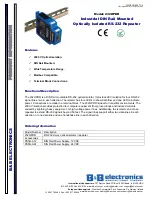
12
Heater Plumbing
Follow these guidelines and considerations:
• There are a few plumbing accessories included with the kit (Connectors and molded hoses)
• Use 3/4” hoses to optimize coolant flow.
• Keep the pick up and return points as far apart as possible.
• Take coolant from a high pressure point of the engine (ie. back of block)
• Return coolant to a low pressure point of the engine (ie. engine’s coolant pump).
• Use ball valves to isolated the system when not in use.
• Take the coolant from a low point on the engine to minimize aeration.
• Mount heater and coolant pump low to allow the purging of air.
• Consider using insulation around the hoses.
• A heat exchange can be incorporated into the system. However, ensure that the heater flow can never be
completely blocked by a flow control valve.
• Do not work on the plumbing system when it is hot or under pressure.
• Do not work on the heater or plumbing system when the heater or engine are in operation.
• Always wear safety gloves and appropriate eye protection.
• Ensure system has pressure relief protection limiting maximum system pressure to 15 PSI (1 bar).
• Coolant flow must never be blocked during heater operation (ie. flow control valves).
Tech Tip
:
Test the flow by feeling the incoming and outgoing hoses. In a system with proper coolant flow, the output
temperature will not exceed the input temperature by more than 10°C (18°F).
The coolant liquid must contain at least 10% antifreeze all year round as a corrosion protection.
*Figure P2
Warning - Burn & Explosion Hazards
Caution













































